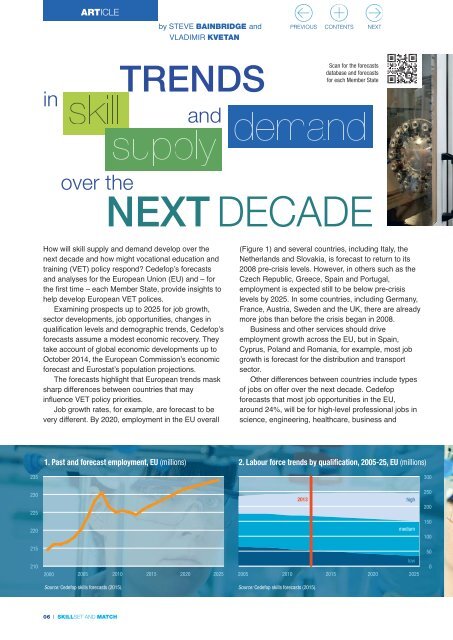PROMOTING LEARNING FOR WORK
9100_en
9100_en
You also want an ePaper? Increase the reach of your titles
YUMPU automatically turns print PDFs into web optimized ePapers that Google loves.
ARTICLE<br />
by STEVE BAINBRIDGE and<br />
VLADImIR KVETAN<br />
in<br />
TRENDS<br />
and<br />
Scan for the forecasts<br />
database and forecasts<br />
for each Member State<br />
over the<br />
NEXT DECADE<br />
How will skill supply and demand develop over the<br />
next decade and how might vocational education and<br />
training (VET) policy respond? Cedefop’s forecasts<br />
and analyses for the European Union (EU) and – for<br />
the first time – each member State, provide insights to<br />
help develop European VET polices.<br />
Examining prospects up to 2025 for job growth,<br />
sector developments, job opportunities, changes in<br />
qualification levels and demographic trends, Cedefop’s<br />
forecasts assume a modest economic recovery. They<br />
take account of global economic developments up to<br />
October 2014, the European Commission’s economic<br />
forecast and Eurostat’s population projections.<br />
The forecasts highlight that European trends mask<br />
sharp differences between countries that may<br />
influence VET policy priorities.<br />
Job growth rates, for example, are forecast to be<br />
very different. By 2020, employment in the EU overall<br />
(Figure 1) and several countries, including Italy, the<br />
Netherlands and Slovakia, is forecast to return to its<br />
2008 pre-crisis levels. However, in others such as the<br />
Czech Republic, Greece, Spain and Portugal,<br />
employment is expected still to be below pre-crisis<br />
levels by 2025. In some countries, including Germany,<br />
France, Austria, Sweden and the Uk, there are already<br />
more jobs than before the crisis began in 2008.<br />
Business and other services should drive<br />
employment growth across the EU, but in Spain,<br />
Cyprus, Poland and Romania, for example, most job<br />
growth is forecast for the distribution and transport<br />
sector.<br />
Other differences between countries include types<br />
of jobs on offer over the next decade. Cedefop<br />
forecasts that most job opportunities in the EU,<br />
around 24%, will be for high-level professional jobs in<br />
science, engineering, healthcare, business and<br />
1. Past and forecast employment, EU (millions)<br />
2. Labour force trends by qualification, 2005-25, EU (millions)<br />
235<br />
300<br />
230<br />
225<br />
2013<br />
high<br />
250<br />
200<br />
150<br />
220<br />
medium<br />
100<br />
215<br />
210<br />
2000 2005 2010 2015 2020 2025 2005 2010 2015 2020 2025<br />
low<br />
50<br />
0<br />
Source: Cedefop skills forecasts (2015).<br />
Source: Cedefop skills forecasts (2015).<br />
06 | SKILLSET AND MATCH


